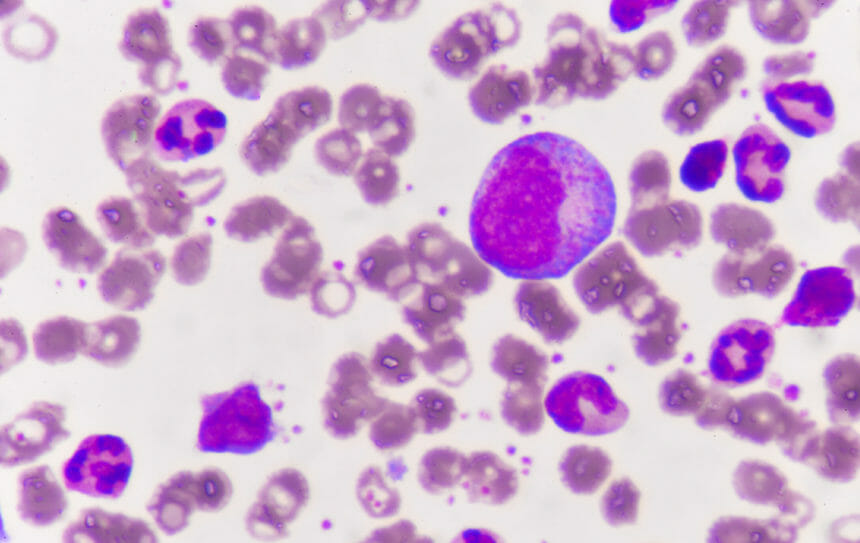Chronic myeloid leukemia (CML), also known as chronic myelogenous leukemia, accounts for about 15% of adult leukemia cases.¹ One of the rarest types of leukemia, CML starts in the bone marrow and causes a dangerous increase in the numbers of abnormal white blood cells.
Although CML treatment has advanced significantly over the years, detecting it earlier is crucial to survival and post-treatment quality of life. Such detection can be difficult because people with chronic forms of leukemia may not have symptoms for years. If patients are being tested for or newly diagnosed with CML, education may be needed. What are some of the basics about chronic myeloid leukemia that you can break down for patients?
Chronic Myeloid Leukemia Symptoms
Because of the time it can take for symptoms to appear, patients may receive a diagnosis of CML after a blood test before they notice any symptoms.² Some of these symptoms include:
- Weight loss
- Weakness and fatigue
- Bone pain
- Fever
- Loss of appetite
- Feeling full after a small amount of food
- Bleeding easily
- Pain or fullness in the belly and ribs

Chronic Myeloid Leukemia Risk Factors
Even medical professionals still don’t understand exactly what triggers CML. What is known is that it is due to an abnormal chromosome developing in the genes of bone marrow cells.² As a result, identifying the specific risk factors of CML can be difficult. Chronic myeloid leukemia is not thought to be inherited, and lifestyle factors such as smoking and diet are not considered to be risk factors.³
Two general factors considered to increase risk are age and gender. CML is very rare in childhood, and in adults older age is believed to increase risk. It is more common in men.
Being exposed to high levels of radiation may increase CML risk. This means that radiation therapy for other forms of cancer may raise the risk for developing CML.
Chronic Myeloid Leukemia Diagnosis and Detection
Chronic myeloid leukemia is sometimes discovered after something as routine as a physical examination when blood tests reveal an abnormally high white blood cell count. To confirm the diagnosis, health care providers may also perform bone marrow aspirations or biopsies or genetic testing to find abnormal chromosomes.⁴
After the patient has been diagnosed, the clinician will determine the stage of CML and whether it has spread. The phases of CML are determined by how many cells in the blood and bone marrow are immature, abnormal cells that are sometimes called blast cells.⁵ These phases are:
- Chronic phase CML means less than 10% of cells are blast cells.
- Accelerated phase CML means 10% to 19% of cells are blast cells.
- Blastic phase CML means at least 20% of cells are blast cells.
Chronic Myeloid Leukemia Treatment
There are several treatment options for CML. Patients and their health care providers can discuss which treatment is best for them based on the phase of their disease and other individual factors. Treatments include:
- Targeted therapy
- Chemotherapy
- Stem cell transplants
- Immunotherapy
- Donor infusion
- Splenectomy
References
1. Chronic myeloid leukemia (CML). American Cancer Society. https://www.cancer.org/cancer/chronic-myeloid-leukemia.html. Accessed May 26, 2021.
2. Chronic myelogenous leukemia – symptoms and causes. Mayo Clinic. https://www.mayoclinic.org/diseases-conditions/chronic-myelogenous-leukemia/symptoms-causes/syc-20352417. Accessed May 27, 2021.
3. Risk factors for chronic myeloid leukemia. American Cancer Society. https://www.cancer.org/cancer/chronic-myeloid-leukemia/causes-risks-prevention/risk-factors.html. Revised June 19, 2018. Accessed May 27, 2021.
4. Tests for chronic myeloid leukemia. American Cancer Society. https://www.cancer.org/cancer/chronic-myeloid-leukemia/detection-diagnosis-staging/how-diagnosed.html. Revised April 1, 2021. Accessed May 27, 2021.
5. Chronic myelogenous leukemia treatment (PDQ®) – patient version. National Cancer Institute. https://www.cancer.gov/types/leukemia/patient/cml-treatment-pdq#_31. Updated April 8, 2021. Accessed May 27, 2021.
